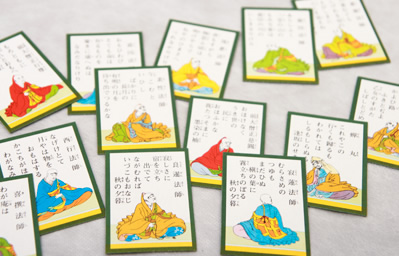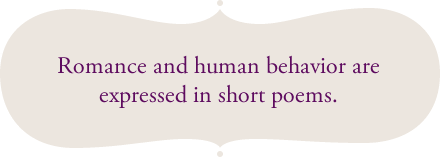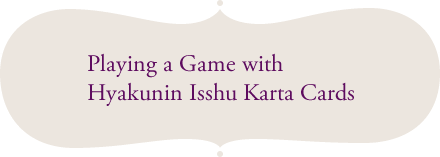"Hyakunin Isshu" usually refers to the "Ogura Hyakunin Isshu," a classical anthology of poems compiled by Fujiwara-no-Teika at his residence in Mt. Ogura in Kyoto in the latter half of the Kamakura Period. Teika selected 100 poems, one each from 100 aristocrats and poets after the Asuka Period. Each poem is composed of 31 Japanese characters or syllables with the form 5-7-5-7-7. The content of the poems cover a wide variety of topics ranging from romance to everyday life. By reading these poems, you can learn about the lives of the people in those periods and imagine what it was like.
In the Muromachi Period, Hyakunin Isshu was further popularized as a good way to introduce people to poetry. In the Edo Period, these cards came to be used as playing cards called "Uta Garuta" with beautiful drawings. With these playing cards, 100 poems are written on two sets of cards that make up one full deck. Players have to quickly match the cards to complete a poem.
In modern times, the poems have become familiar to the Japanese people as they are often used to educate junior high and high school students in classical literature. The cards have come to be known as "Hyakunin Isshu Karuta" and are used to play games during the New Year season. There is even a national tournament for playing competitive Karuta.
A Popular Way to Play Hyakunin Isshu
100 "Torifuda" or grabbing cards are scattered face up on the floor. A Torifuda only has the last two lines (14 characters) of a 31 character poem.
The reader has a deck of 100 "Yomifuda" or reading cards. Yomifuda contains the complete 31 character poem. The reader reads a poem one by one.
Players must find and take the Torifuda that matches the poem being read by the reader. As you can imagine, you'll be able to find the card quicker if you know the last two lines to each poem. The game ends when all 100 poems have been read. Whoever has taken the most cards is the winner.
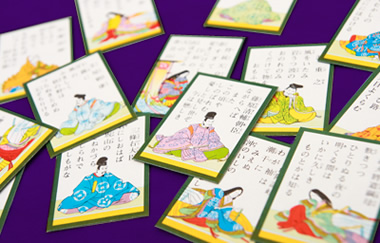
"Yomifuda" or reading cards from Hyakunin Isshu Karta. Each card contains a poem and a colorful portrait of the poet. 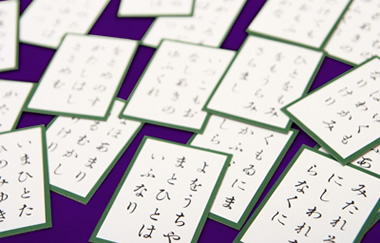
"Torifuda" or grabbing cards from Hyakunin Isshu Karta. Only the last two lines of each poem (14 characters) are written on these cards.
Here are some famous poems from Hyakunin Isshu which contains various topics like human behavior, romance and nature.
"Haru Sugite / Natsu Kini Kerashi / Shirotaeno / Koromo Hosuchou / Amano Kaguyama"

- Spring has gone and summer is already here. Many white kimonos are being dried on Mount Kaguyama.

- One theory says that there actually were white kimonos being dried, while another says that the snow on the mountaintop looked like white kimonos. Either way, this poem sings about the changing of the seasons and human behavior in a feminine style.
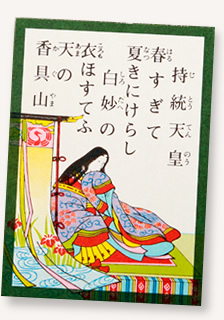
"Koreya Kono / Yukumo Kaerumo / Wakareteha / Shirumo Shiranumo / Ausaka no Seki"

- This is that famous Ausaka pass, where people on their way east or going back to Kyoto in the west meet and separate. People who know each other as well as people who don't know each other meet here.

- It is believed that the poet created this poem while watching people go through the Ausaka Pass. This is a very famous poem about the meeting and separation of people.
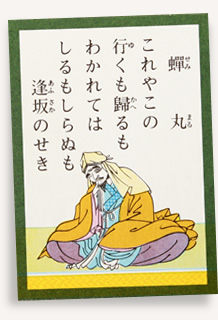
"Ashibiki no / Yamadori no O no / Shidari O no / Naganagashi Yo wo / Hitori Kamo Nen"

- Male and female mountain birds are said to sleep apart during the night. Am I to sleep alone during the long, long night like the long, drooping tail of a mountain bird?

- This poem refers to the mountain bird to express the hopelessly sad feeling of romance.
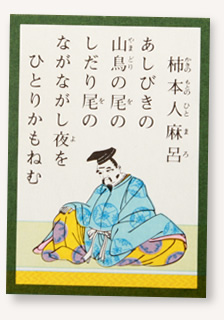
Various games can be played using Hyakunin Isshu Karuta cards. Here, we introduce a simple game that can be played by more than two people, even if you don't understand Japanese.
The game makes use of the fact that there are 15 poems by monks.
- 1.Place a deck of 100 Yomifuda cards face down. Players take turns drawing one card at a time, performing one of the following three actions depending on the card. After the action, it is the next player's turn. This continues until there are no more cards in the pile.
- - If the player draws a card with a portrait of a man, the player keeps the card.
- - If the player draws a card with a portrait of a monk ("Bouzu" in Japanese), the player places all of his/her cards beside the pile as a "discard pile."
- - If the player draws a card with a portrait of a woman, the player takes all cards in the discard pile.
- 2.The game ends when there are no more cards in the (main) pile. The player with the most cards wins.
